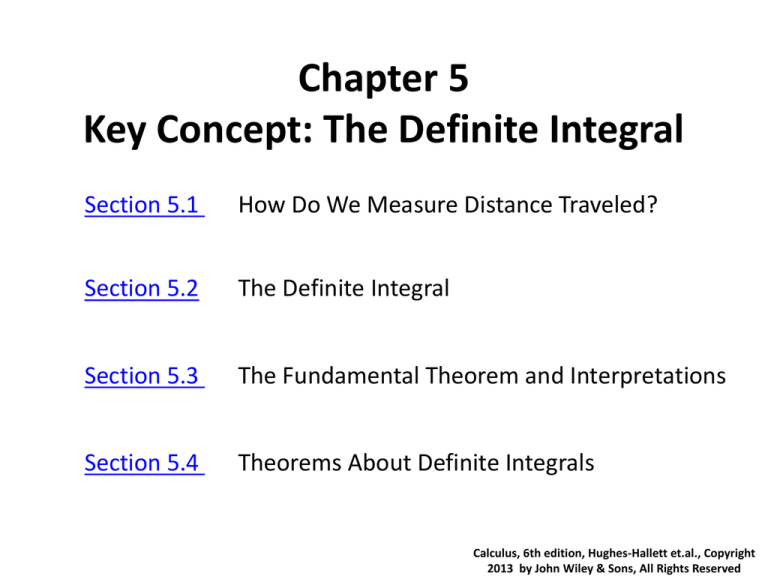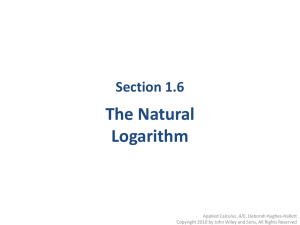
Chapter 5
Key Concept: The Definite Integral
Section 5.1
How Do We Measure Distance Traveled?
Section 5.2
The Definite Integral
Section 5.3
The Fundamental Theorem and Interpretations
Section 5.4
Theorems About Definite Integrals
Calculus, 6th edition, Hughes-Hallett et.al., Copyright
2013 by John Wiley & Sons, All Rights Reserved
Section 5.1
How Do We Measure
Distance Traveled?
Calculus, 6th edition, Hughes-Hallett et.al., Copyright
2013 by John Wiley & Sons, All Rights Reserved
Estimating the Distance a Car Travels
A car is moving with increasing velocity. Table 5.1 shows the
velocity every two seconds:
We might estimate the distance traveled by assuming a
constant velocity in each interval and use the formula
distance = velocity × time
At least how far has the car traveled?
20 · 2 + 30 · 2 + 38 · 2 + 44 · 2 + 48 · 2 = 360 feet.
At most how far has the car traveled?ining the data
30 · 2 + 38 · 2 + 44 · 2 + 48 · 2 + 50 · 2 = 420 feet.1:
Calculus, 6th edition, Hughes-Hallett et.al., Copyright
2013 by John Wiley & Sons, All Rights Reserved
How Do We Improve Our Estimate?
Table 5.2
Time (sec)
Velocity of car every second
0
1
2
3
4
5
6
7
8
9
10
Speed (ft/sec) 20 26 30 34 38 41 44 46 48 49 50
New lower estimate = 20 · 1 + 26 · 1 + 30 · 1 + 34 · 1 + 38 · 1
+ 41 · 1 + 44 · 1 + 46 · 1 + 48 · 1 + 49 · 1
= 376 feet > 360 feet
New upper estimate = 26 · 1 + 30 · 1 + 34 · 1 + 38 · 1 + 41 · 1
+ 44 · 1 + 46 · 1 + 48 · 1 + 49 · 1 + 50 · 1
= 406 feet < 420 feet
The difference between upper and lower estimates is now 30
feet, half of what it was before. By halving the interval of
measurement, we have halved the difference between the upper
and lower estimates.
Calculus, 6th edition, Hughes-Hallett et.al., Copyright
2013 by John Wiley & Sons, All Rights Reserved
Visualizing Distance on the Velocity Graph:
Two-Second Data
To visualize the difference between the two estimates, look at
Figure 5.1 and imagine the light rectangles all pushed to the right
and stacked on top of each other, giving a difference of 30×2=60.
Figure 5.1: Velocity measured every 2 seconds
Calculus, 6th edition, Hughes-Hallett et.al., Copyright
2013 by John Wiley & Sons, All Rights Reserved
Visualizing Distance on the Velocity Graph:
One-Second Data
To visualize the difference between the two estimates, look at Figure 5.2.
This difference can be calculated by stacking the light rectangles vertically,
giving a rectangle of the same height as before but of half the width. Its
area is therefore half what it was before. Again, the height of this stack is
30, but its width is now 1, giving a difference 30.
Figure 5.2: Velocity measured every second
Calculus, 6th edition, Hughes-Hallett et.al., Copyright
2013 by John Wiley & Sons, All Rights Reserved
If the velocity is positive, the total distance traveled
is the area under the velocity curve.
Figure 5.3:
Velocity
measured every
½ second
Figure 5.4:
Velocity
measured every
¼ second
Figure 5.5:
Distance
traveled is area
under curve
Calculus, 6th edition, Hughes-Hallett et.al., Copyright
2013 by John Wiley & Sons, All Rights Reserved
Left- and Right-Hand Sums
If f is an increasing function, as in Figures 5.8 and 5.9, the left-hand sum is
an underestimate and the right-hand sum is an overestimate of the total
distance traveled. If f is decreasing, as in Figure 5.10 (next slide), then the
roles of the two sums are reversed.
Figure 5.8: Left-hand sums
Figure 5.9: Right-hand sums
Calculus, 6th edition, Hughes-Hallett et.al., Copyright
2013 by John Wiley & Sons, All Rights Reserved
Left- and Right-Hand Sums
Figure 5.10: Left
and right sums
if f is decreasing
For either increasing or decreasing velocity functions, the exact value of the
distance traveled lies somewhere between the two estimates. Thus, the
accuracy of our estimate depends on how close these two sums are. For a
function which is increasing throughout or decreasing throughout the interval
[a, b]: Difference between upper and lower estimates = |f(b)-f(a)|Δt.
Calculus, 6th edition, Hughes-Hallett et.al., Copyright
2013 by John Wiley & Sons, All Rights Reserved
Section 5.2
The Definite Integral
Calculus, 6th edition, Hughes-Hallett et.al., Copyright
2013 by John Wiley & Sons, All Rights Reserved
Sigma Notation
Suppose f(t) is a continuous function for a ≤ t ≤ b. We divide the interval from
a to b into n equal subdivisions, and we call the width of an individual
subdivision Δt, so
ba
t
n
Let t0, t1, t2, . . . , tn be endpoints of the subdivisions. Both the left-hand and
right-hand sums can be written more compactly using sigma, or summation,
notation. The symbol Σ is a capital sigma, or Greek letter “S.” We write
n
Right - hand sum f (t1 )t f (t 2 )t f (t n )t f (ti )t
i 1
The Σ tells us to add terms of the form f(ti) Δt. The “i = 1” at the base of the
sigma sign tells us to start at i = 1, and the “n” at the top tells us to stop at i =
n. In the left-hand sum we start at i = 0 and stop at i = n − 1, so we write
n 1
Left - hand sum f (t0 )t f (t 2 )t f (t n 1 )t f (ti )t
i 0
Calculus, 6th edition, Hughes-Hallett et.al., Copyright
2013 by John Wiley & Sons, All Rights Reserved
Taking the Limit to Obtain the Definite Integral
Suppose f is continuous for a ≤ t ≤ b. The definite integral of f
b
from a to b, written
f (t )dt,
a
is the limit of the left-hand or right-hand sums with n
subdivisions of a ≤ t ≤ b as n gets arbitrarily large. In other
words,
b
n 1
f
(
t
)
dt
lim
(Left
hand
sum)
lim
f
(
t
)
t
i
a
n
n
i 0
and
b
n
f
(
t
)
dt
lim
(Right
hand
sum)
lim
f
(
t
)
t
.
i
a
n
n
i 1
Each of these sums is called a Riemann sum, f is called the
integrand, and a and b are called the limits of integration.
Calculus, 6th edition, Hughes-Hallett et.al., Copyright
2013 by John Wiley & Sons, All Rights Reserved
Computing a Definite Integral
Figure 5.20:
Approximating
21
1 t dt with n = 2
Figure 5.21:
Approximating
21
1 t dt with n = 10
Figure 5.22: Shaded
area is exact value of
21
1 t dt
When n = 250, a calculator or computer gives 0.6921 <
So, to two decimal places, we can say that
2
The exact value is known to be 1
2
1
1
dt 0.69.
t
2
1
1
dt < 0.6941.
t
1
dt ln 2 0.693147 See Figure 5.22.
t
Calculus, 6th edition, Hughes-Hallett et.al., Copyright
2013 by John Wiley & Sons, All Rights Reserved
The Definite Integral as an Area
Figure 5.23: Area of rectangles
approximating the area under the curve
Figure 5.24: Shaded area is the definite
integral
Calculus, 6th edition, Hughes-Hallett et.al., Copyright
2013 by John Wiley & Sons, All Rights Reserved
When f (x) Is Not Positive
When f (x) is positive for some x values and negative for
b
others, and a < b:
a
f ( x)dx.
is the sum of areas above the x-axis, counted positively,
and areas below the x-axis, counted negatively.
Figure 5.26: Integral
x
1
1
is negative of shaded area
2
1 dx
Figure 5.27: Integral
0
2
sin x 2 dx A1 A2
Calculus, 6th edition, Hughes-Hallett et.al., Copyright
2013 by John Wiley & Sons, All Rights Reserved
More General Riemann Sums
A general Riemann sum for
f on the interval [a, b] is a sum
n
of the form
f (c )t ,
i 1
i
i
where a = t0 < t1 < · · · < tn = b, and, for i = 1, . . . , n,
Δti = ti − ti−1, and ti−1 ≤ ci ≤ ti
Figure 5.28: A general Riemann sum approximating
b
a
f (t )dt
Calculus, 6th edition, Hughes-Hallett et.al., Copyright
2013 by John Wiley & Sons, All Rights Reserved
Section 5.3
The Fundamental Theorem
and Interpretations
Calculus, 6th edition, Hughes-Hallett et.al., Copyright
2013 by John Wiley & Sons, All Rights Reserved
The Fundamental Theorem of Calculus
Theorem 5.1: The Fundamental Theorem of Calculus
If f is continuous on the interval [a, b] and f(t) = F′(t), then
b
a
f (t )dt F (b) F (a)
F(b) − F(a) = Total change in F(t) between t = a and t = b
b
= F ' (t )dt
a
In words, the definite integral of a rate of change gives the
total change.
Since the terms being added up are products of the formb “f(x)
times a difference in x,” the unit of measurement for a f (t )dt
is the product of the units for f(x) and the units for x.
Calculus, 6th edition, Hughes-Hallett et.al., Copyright
2013 by John Wiley & Sons, All Rights Reserved
The Definite Integral of a Rate of Change:
Applications of the Fundamental Theorem
Example 2
Let F(t) represent a bacteria population which is 5 million at time t = 0.
After t hours, the population is growing at an instantaneous rate of 2t
million bacteria per hour. Estimate the total increase in the bacteria
population during the first hour, and the population at t = 1.
Solution
Since the rate at which the population is growing is F′(t) = 2t, we have
Change in population = F(1) − F(0) =
Using a calculator to evaluate the integral,
1
0
2t dt
1
t
Change in population = 2 dt 1.44 million bacteria
0
Since F(0) = 5, the population at t = 1 is given by
Population = F(1) = F(0) +
1
0
2t dt 5 1.44 6.44 million bacteria
Calculus, 6th edition, Hughes-Hallett et.al., Copyright
2013 by John Wiley & Sons, All Rights Reserved
Calculating Definite Integrals:
Computational Use of the Fundamental Theorem
Example 5
Compute
3
2 x dx
1
by two different methods.
Solution
Using left- and right-hand sums, we can approximate this integral as
accurately as we want. With n = 100, for example, the left-sum is 7.96 and the
right sum is 8.04. Using n = 500 we learn
3
7.992 2 x dx 8.008
1
The Fundamental Theorem, on the other hand, allows us to compute the
integral exactly. We take f(x) = 2x. We know that if F(x) = x2, then F′(x) = 2x. So
we use f(x) = 2x and F(x) = x2 and obtain
3
1
2 x dx F (3) F (1) 32 12 8.
Notice that to use the Fundamental Theorem to calculate a definite integral,
we need to know the antiderivative, F. Chapter 6 discusses how
antiderivatives are computed.
Calculus, 6th edition, Hughes-Hallett et.al., Copyright
2013 by John Wiley & Sons, All Rights Reserved
Section 5.4
Theorems About
Definite Integrals
Calculus, 6th edition, Hughes-Hallett et.al., Copyright
2013 by John Wiley & Sons, All Rights Reserved
Properties of the Definite Integral
Theorem 5.2: Properties of Limits of Integration
If a, b, and c are any numbers and f is a continuous function,
b
a
then
1. f ( x)dx f ( x)dx
a
2.
c
a
b
b
b
c
a
f ( x)dx f ( x)dx f ( x)dx
In words:
1. The integral from b to a is the negative of the integral
from a to b.
2. The integral from a to c plus the integral from c to b is the
integral from a to b. (This property holds for all numbers a,
b, and c, not just for those satisfying a < c < b.)
Calculus, 6th edition, Hughes-Hallett et.al., Copyright
2013 by John Wiley & Sons, All Rights Reserved
Properties of the Definite Integral
Theorem 5.3: Properties of Sums and Constant
Multiples of the Integrand
Let f and g be continuous functions and let c be a constant.
1.
2.
f ( x) g( x)dx
b
b
a
a
b
a
b
f ( x)dx g ( x)dx
a
b
c f ( x)dx c f ( x)dx
a
In words:
1. The integral of the sum (or difference) of two functions is
the sum (or difference) of their integrals.
2. The integral of a constant times a function is that constant
times the integral of the function.
Calculus, 6th edition, Hughes-Hallett et.al., Copyright
2013 by John Wiley & Sons, All Rights Reserved
Area Between Curves
If the graph of f(x) lies above the graph of g(x) for a ≤ x ≤ b,
then
b
Area between f and g
f ( x) g( x)dx
a
for a ≤ x ≤ b
Example 3
Find the area of the
shaded region between
two parabolas in
figure 5.57 to the right.
Solution
The points of intersection must be determined first. Equating f(x) to g(x)
and solving for x gives x = 1 and 3. Then, applying Theorem 5.4:
( x
3
1
2
3
4 x 1) ( x 4 x 5) dx 2 x 2 8x 6 dx 2.667
2
1
Calculus, 6th edition, Hughes-Hallett et.al., Copyright
2013 by John Wiley & Sons, All Rights Reserved
Using Symmetry to Evaluate Integrals
If f is even, then
If g is odd, then
Figure 5.58: For an even function,
a
a
a
f ( x)dx 2 f ( x)dx
0
a
a
a
a
a
f ( x) dx 2 f ( x)dx
0
g ( x)dx 0
Figure 5.58: For an odd function,
a
a
g( x)dx 0
Calculus, 6th edition, Hughes-Hallett et.al., Copyright
2013 by John Wiley & Sons, All Rights Reserved
Comparing Integrals
Theorem 5.4: Comparison of Definite Integrals
Let f and g be continuous functions.
b
1. If m ≤ f(x) ≤ M for a ≤ x ≤ b, then m(b a) f ( x)dx M (b a)
a
2. If f(x) ≤ g(x) for a ≤ x ≤ b, then
Figure 5.62: The area under the graph of
f lies between the areas of the rectangles
b
a
b
f ( x)dx g( x)dx
a
Figure 5.63: If f(x) ≤ g(x) then
b
a
b
f ( x)dx g( x)dx
a
Calculus, 6th edition, Hughes-Hallett et.al., Copyright
2013 by John Wiley & Sons, All Rights Reserved
The Definite Integral as an Average
Average value of f
from a to b
1
ba
b
f ( x)dx
a
How to Visualize the Average on a Graph
The definition of average value tells us that
b
(Average value of f) · (b − a) f ( x)dx
a
Figure 5.65: Area and average value
Calculus, 6th edition, Hughes-Hallett et.al., Copyright
2013 by John Wiley & Sons, All Rights Reserved
The Definite Integral as an Average
Example 6
Suppose that C(t) represents the daily cost of heating your
house, measured in dollars per day, where t is time measured
in days and t = 0 corresponds to January 1, 2008. Interpret
90
90
1
C (t)dt and
C (t)dt
0
90 0
0
Solution
The units for the first expression are (dollars/day) × (days) =
dollars. The integral represents the total cost in dollars to heat
your house for the first 90 days of 2008, namely the months of
January, February, and March. The second expression is
measured in (1/days)(dollars) or dollars per day, the same
units as C(t). It represents the average cost per day to heat
your house during the first 90 days of 2008.
Calculus, 6th edition, Hughes-Hallett et.al., Copyright
2013 by John Wiley & Sons, All Rights Reserved


![Global max/min [4.3]](http://s2.studylib.net/store/data/005700750_1-6d8aea91972157c1c45aa1008072a9fe-300x300.png)


![Local max/min [4.1]](http://s2.studylib.net/store/data/005703785_1-fddedba53a949b6dd73bfcae3f9e6954-300x300.png)
![Inflection points [4.2]](http://s2.studylib.net/store/data/005711558_1-7e6caa30b78ed23b978b40c18112cd02-300x300.png)
